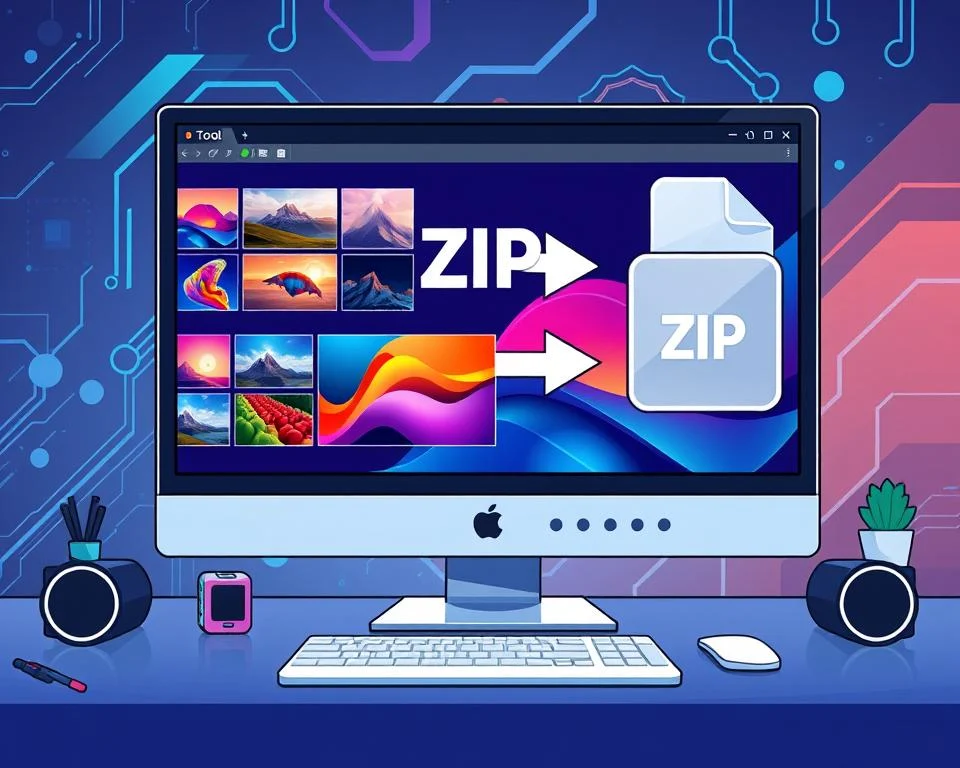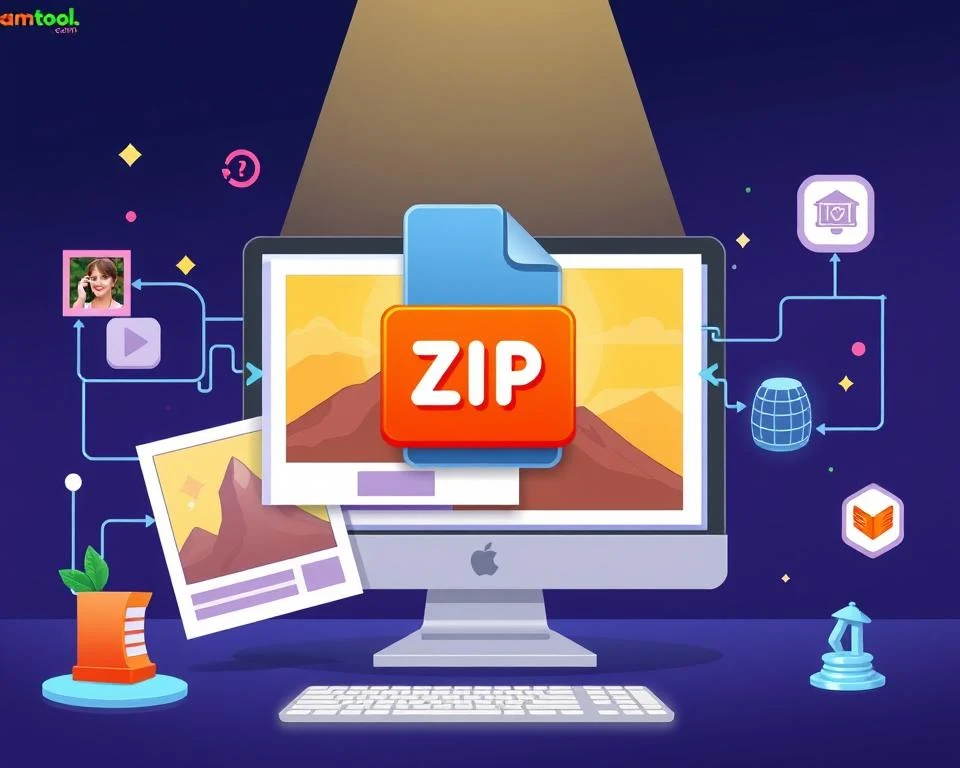Image to ZIP Converter
How to use this tool website
Convert Images to ZIP Files Easily
In today's digital world, managing and sharing image files can be tough, especially with large sizes. But, there's a simple way to make things easier - converting your images to ZIP files. This guide will show you how to compress your images into ZIP format.

This makes saving space, transferring files faster, and organizing your digital stuff easier.
Key Takeaways
- Discover the benefits of compressing images into ZIP files
- Learn about popular image to ZIP converter tools
- Understand step-by-step instructions for converting images to ZIP
- Explore best practices and tips for optimizing compression levels
- Discover advanced techniques for batch conversion and automation
Effortless Image Compression with ZIP
Compressing your images into a ZIP file has many benefits. It makes your workflow smoother and optimizes your digital content. If you're a photographer, web developer, or just need to share images, an image to ZIP converter is worth looking into.
The Benefits of Compressing Images into ZIP Files
- Reduced file size: Zipping your images makes them smaller, which is great for storing, sharing, and uploading online.
- Improved organization: Putting multiple images in one ZIP file helps with managing large collections.
- Enhanced sharing capabilities: Sending a ZIP file is often easier than attaching many files one by one.
Scenarios Where Zipping Images is Useful
Compressing images to ZIP is useful in many situations, such as:
- Web development: Zipping images can make websites load faster and improve user experience.
- E-commerce: For online stores, compressing product images into ZIP files makes uploading and managing them easier.
- Photography portfolios: Sharing your best shots in a ZIP file is a smart way to show your work to clients or employers.
- Email attachments: Zipping images before sending them as attachments makes them smaller and ensures they arrive safely.
Zipping your images is a simple yet powerful way to optimize your digital content and streamline your workflow.
The benefits of zipping images and reasons to compress images to zip are many. It's a versatile tool for many uses. Whether for web development, e-commerce, or personal file management, the convenience and efficiency it offers are clear.
Popular Image to ZIP Converter Tools
There are many best image to zip converter tools and top zip image file converters out there, both free and paid. These tools make it easy to compress and manage your images. They help you turn your images into the compact ZIP format efficiently. Let's look at some top choices:
- Convertio - This free online image to zip converter software lets you upload many images at once. With just a few clicks, you can convert them into a ZIP file. It supports many image formats and has extra features like file compression and batch processing.
- WinZip - A well-known zip tool with an image to zip converter feature. Although it's a paid tool, it has advanced compression and works with various cloud storage services.
- PeaZip - A free and open-source free image to zip converter software that works with different image file types. Its easy-to-use interface and strong compression make it a favorite among users.
These are just a few examples of the top zip image file converters out there. When picking the best image to zip converter tools, think about how easy they are to use, how well they compress files, and if they work with your image types. Also, consider any extra features that might be useful for your work.
Compressing images into ZIP files can greatly reduce file size and simplify file management, making it a valuable tool for various scenarios.
Step-by-Step Guide: Converting Images to ZIP
Want to share many images or make your files smaller? Converting your images to a ZIP archive can help. We'll show you how to do this step by step. This will make your work easier and help you manage your images better.
Selecting the Right Image to ZIP Converter
Choosing the right tool is the first step in converting images to ZIP. You can find many options online and on your computer. Look for ease of use, file formats supported, compression quality, and extra features you might need.
Preparing Your Image Files for Compression
Before converting, make sure your images are ready. You might need to improve the image quality, resize them, or organize your files. Doing this ensures your ZIP file is as small and efficient as possible.

- Gather all the images you want to convert into a ZIP file.
- Review the image files and make any necessary edits or optimizations, such as resizing or adjusting the quality.
- Organize your image files into logical folders or directories, if applicable.
- Identify the image to ZIP converter tool you will use for the conversion process.
By following these steps, you'll be ready to make a ZIP file that packs your images well for sharing or storage. Remember, preparation and choosing the right tool are key to a successful conversion.
Image to ZIP Converter: Best Practices and Tips
Optimizing your image to ZIP conversion process can help you get the best results. You'll get smaller file sizes and keep the image quality high. By following some best practices and tips, you can make your workflow smoother and improve your image compression.
Optimizing Compression Levels for Best Results
The compression level you pick when making a ZIP file affects the file size and image quality. Higher levels make files smaller but might lose some image quality. To get the best balance, try different settings and see what works best.
- Start with a moderate compression level (e.g., 6 or 7 out of 10) and check the results.
- If the file is still too big, increase the compression level a bit at a time, watching the image quality.
- If the image looks bad, lower the compression level until it looks good again.
"Finding the perfect balance between file size and image quality is key to getting the best results from your image to ZIP conversion."
By optimizing your compression levels, you can make ZIP files that are small and still look great.
There are more tips to keep in mind when converting images to ZIP files. These include:
- Make sure your source images are high-quality and not already compressed.
- Pick the right image file format (like JPEG or PNG) for your images.
- Use batch processing to convert many images at once for speed.
- Check your ZIP files often to make sure they open and look right.
By using these best practices for image to zip conversion, tips for compressing images to zip, and optimizing zip file compression, you can make ZIP files that are great in quality and save space. This will please your audience and meet your needs.
Advanced Techniques: Batch Conversion and Automation
For those who often need to convert lots of images to ZIP files, advanced methods like batch conversion and automation can make things easier and faster. These tools let you quickly convert many images to ZIP at once, making the process automatic.
Batch Convert Images to ZIP
Batch conversion changes the game for dealing with many image files. You can pick a bunch of files and turn them all into a ZIP archive with just a few clicks. This saves time and keeps your images compressed and organized consistently.
Automate Image to ZIP Conversion
Take your image to ZIP conversion further by using automation. With special software and scripts, you can set up a system to watch folders for new images. Then, it will automatically compress them into ZIP archives. This way, you can focus on other tasks while your images are being taken care of.
Advanced image to ZIP conversion methods like batch processing and automation cut down on manual tasks. They help you work more efficiently and increase your productivity.
Automating the image to ZIP conversion process has been a game-changer for my team. It's saved us countless hours and ensures our files are always neatly organized.
If you're a pro photographer, content creator, or just manage a big collection of images, these advanced techniques can really boost your efficiency and productivity. Check out batch conversion and automation to elevate your image management.
Troubleshooting Common Issues with Image to ZIP Converters
Converting images to ZIP files is usually easy, but sometimes you might run into problems. We'll look at common issues and how to fix them.
One issue is file compatibility. Not every ZIP converter supports all image formats. If a tool won't work with your image, check its supported formats. You might need to change the image format first.
File size limits are another problem. Some tools won't handle big files or large ZIP archives. If you're dealing with big images or many images, look for other options. Or, try compressing them in smaller groups.
Sometimes, ZIP compression can fail, leading to errors like corrupted files or incomplete archives. If this happens, try a different ZIP converter or start over. Make sure your images are okay before zipping them.
FAQ
What are the benefits of compressing images into ZIP files?
Compressing images into a ZIP file reduces their size, saving storage space and making them easier to share. It also helps in organizing and sending large collections of images efficiently.
When is it useful to zip image files?
Zipping images is particularly useful when sending a large number of photos via email, storing them in limited storage, or sharing them over a slow internet connection.
What are some popular image-to-ZIP converter tools?
Popular tools for converting images to ZIP files include WinZip, 7-Zip, PeaZip, and online converters such as Convertio and CloudConvert.
How do I prepare my image files for compression?
To prepare your images for compression, organize them into folders and rename them if necessary. Ensure the images are in standard formats like JPEG or PNG for a smoother conversion process.
How can I optimize the compression levels for the best results?
For optimal results, experiment with different compression levels to find the perfect balance between reduced file size and image clarity.
Can I batch convert multiple images to a ZIP file?
Yes, most tools allow batch conversion, enabling you to compress multiple images into a single ZIP file at once, saving time and effort.
What are some common issues I might encounter with image-to-ZIP conversion?
Common issues include unsupported image formats, corrupted files during compression, or difficulty opening the ZIP file. Using a reliable converter and following best practices can help avoid these problems.













Write a Review
No comments:
Post a Comment